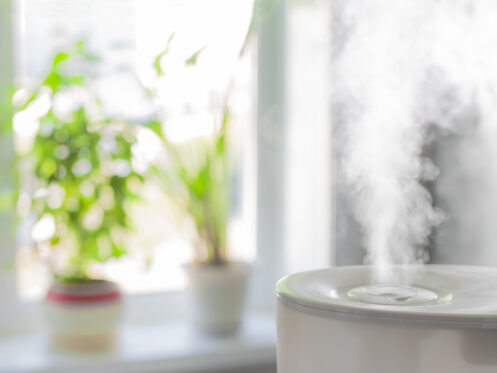Having too much moisture in your Vacaville, CA home can wreak havoc on your property’s value and your health. It can also make being indoors far from pleasant. From blistered, peeling paint to fast-spreading patches of mildew and mold, unchecked humidity takes a considerable toll. Read on to find out what your home’s ideal humidity is and how to achieve it.
What Is Ideal Relative Humidity?
Humidity measures the amount of water vapor in the air. Both indoors and outdoors, humidity is always in a state of flux. As temperatures change, moisture levels rise or fall. Relative humidity measures the amount of moisture vapor currently suspended in the air relative to the amount of moisture that air can hold at its present temperature.
Both too little and too much moisture vapor can prove problematic. Thus, homeowners are advised to maintain indoor humidity levels within an “ideal” range. According to the United States Environmental Protection Agency (EPA), ideal indoor humidity is between 30% and 50% for most households.
What Your HVAC System Can and Cannot Do to Help
In addition to temperature regulation, modern HVAC systems offer limited amounts of air filtration and humidity control. Heat pumps, air conditioners, and condensing furnaces constantly extract moisture vapor during operation. This vapor is condensed and routed out of homes via HVAC condensate drains.
Your HVAC System Is Not Built to Add Humidity
For homes with balanced humidity, the limited humidity control provided by HVAC systems is sufficient to prevent problems like wet windows and drywall, mold formation, and warped building materials. However, residential HVAC systems aren’t designed to add moisture to indoor air. Thus, if your air is overly dry, you may need whole-house humidification equipment. Whole-house humidifiers are integrated HVAC accessories that are installed in ductwork or attached to it. These units add moisture to conditioned air just before distribution.
Not-Serviced and Under-Serviced Building Areas
Your HVAC system could have a hard time extracting excess moisture if one or more rooms are either not serviced or under-serviced by your heating and cooling equipment. In many homes, areas like garden rooms and laundry rooms are heavy with moisture but lack attached ducting or are too far from air handlers for effective moisture removal.
Reasons Why Your Indoor Air May Be Too Moist
According to the EPA, problems like perpetually wet foundations, slab leaks, and hidden leaks are among the most common causes of chronically high humidity. Scheduling a whole-house plumbing inspection each year will ensure that ongoing leaks at the backs of appliances or in crawlspaces aren’t affecting your property’s value, your indoor air quality (IAQ), or your health.
Dirty HVAC Air Filters
Although HVAC systems aren’t built to add moisture to homes, they often do when experiencing serious airflow issues. You should inspect your HVAC air filter every 30 days and change it as needed. For most households, the ideal filter replacement schedule is every one to three months.
Operating your heater, air conditioner, or heat pump with a dirty air filter in it can leave your living space feeling oppressive and muggy. Prolonged airflow issues can also result in HVAC problems like short cycling and shutdown.
Insufficient Heating and Cooling System Maintenance
In addition to replacing your air filter, you should also schedule annual maintenance services. This gives HVAC technicians the chance to remove build-ups of debris that have bypassed HVAC air filters. HVAC system tune-ups optimize airflow and keep building interiors from feeling clammy.
Closed HVAC Air Vents
If you’re up to date with filter changes and annual heater and air conditioner maintenance, you should check the HVAC air vents throughout your home to verify that they’re open. Total vent closures increase the air pressure within HVAC ducting. This also inhibits airflow and can lead to icing, overheating, shutdown, and increased humidity.
Blocked Exhaust Vents and Poor Ventilation
Your home can also be overly humid due to blocked vents and insufficient ventilation. You should clean your stove’s range hood vent screen every 30 days. You should inspect and clean your bathroom exhaust fans annually and have your dryer’s vent cleaned every six to 12 months.
Common Causes of Overly Dry Indoor Air
Colder temperatures invariably bring drier indoor and outdoor air. Running your central heating system often will make your indoor air even drier. In some homes, insufficient insulation further compounds this problem.
Why is dry air problematic? Common symptoms of overly dry indoor air include increased static electricity, nasal and sinus irritation, congestion, dry skin and hair, and frequent nosebleeds. Dry indoor air can negatively affect your sleep. If left unchecked, it can also lead to warped building materials, split or cracked wood elements, and high concentrations of dust, dander, and other airborne particulates.
The Benefits of Whole-House Humidifiers and Dehumidifiers
Whole-house humidifiers and dehumidifiers protect both properties and people. They help homeowners maintain ideal relative humidity year-round by either extracting moisture or adding to it as needed. Many of the latest whole-house humidifiers and dehumidifiers also have smart capabilities, and consumers can easily integrate these units with their smart thermostats or other smart home features.
Will Portable Units Work?
Using a portable humidifier to add moisture to your indoor air could cause more problems than it solves. While whole-house humidification and dehumidification equipment balance humidity, portable units disburse water vapor indiscriminately until their tanks are empty. This can leave rooms sodden, soggy, and prone to mold and mildew. Worse still, portable humidifiers are also prone to developing mold problems of their own. Once mold spores form in a humidifier’s filter or in its water tank, all of the moisture released from this unit is contaminated.
High-end portable humidifiers have built-in features for mold prevention. However, the upfront costs of these units can be significantly higher than the cost of whole-house humidifier installation.
How to Know if You Need Help Regulating Your Home’s Humidity
There are several, easy ways to track your home’s relative humidity. You can pay careful attention to the symptoms that residents exhibit to identify serious and ongoing problems with excess or insufficient moisture.
Upgrading your standard or programmable thermostat to a smart thermostat will provide greater insight. Many smart thermostats track indoor air quality and indoor humidity while offering real-time data and helpful reports.
However, scheduling an IAQ assessment is the best way to determine how high your indoor humidity is. This evaluation will give you an exact measurement of moisture vapor relative to your home’s current temperature. It will also tell you which allergens, pathogens, and gaseous chemicals are present and list their respective concentrations.
We help residents of Vacaville, CA maintain clean, comfortable, and all-around healthy homes. We provide outstanding heating, cooling, and plumbing services. Our clients can also count on us for new ductwork, electrical services, solar installation, and cutting-edge indoor air quality improvements. For help balancing the humidity in your home, call Cozy Home Services today.



